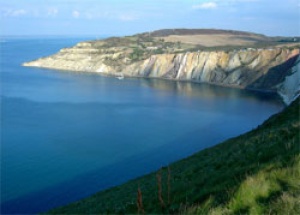Isle of Wight is safe from Triffids

At the end of John Wyndham’s 1950s classic sci-fi novel The Day of the Triffids, shown on BBC TV over the New Year, the hero and heroine make their escape from the UK mainland and its man-eating plants to the safety of a new world colony on the Isle of Wight. Half a century after the publication of the post-apocalyptic novel, the Island remains a safe haven for endangered flora and fauna and a holiday playground for the eco-orientated. Wightlink’s free, downloadable Rare Plant Trail guide is one way to check out the safe locations for wildlife and its Green Getaways eco-holiday hideaways provide rural accommodation close to the wild (0871 376 0013 www.wightlink.co.uk).
What to see on the Isle of Wight:
Endangered creatures: the red squirrel is undoubtedly the most famous of many rare fauna that have sheltered on the Isle of Wight, safe from mainland predators. Others include the retiring dormouse, the water vole, the vulnerable Glanville Fritillary, an orange and brown chequered butterfly that has virtually disappeared from the UK and 12 of 15 British bat species - including the nationally rare Bechstein’s Bat.
ADVERTISEMENT
Rare flora: Extra-ordinary plants like the Early Gentian, Toothwort and Narrow-leaved Lungwort are hidden away on the Isle of Wight – and Wightlink’s Rare Plant Trail blows the whistle on where to find them. The guide traces a route around the Isle of Wight to spotlight 20 of the UK’s most noteworthy plants in garden collections, nature reserves and wild Areas of Outstanding Natural Beauty. Some close to extinction on the UK mainland, the plants featured range from some of the country’s largest trees to its tiniest flowering species. Many were chosen because they encourage rare wildlife, like the endangered red squirrel and dormouse and a tremendous variety of rare birds, insects and butterflies.
Twitchers: should flock to the Isle of Wight to see rare birds like the Corn Bunting (indigenous at south coast Whale Chine), the Dartford warbler, Nightjar, Water Rail and a host of Little Egrets. The Island’s top bird sanctuary is, unquestionably, the national nature reserve of Newtown Estuary, a north coast paradise for migrating birds like the Golden Plover and Great Crested Grebe.
Where to stay:
Gotten Manor: Couples can stay in deepest countryside at his romantic stone manor house, located in a sheltered hollow at the foot of St. Catherine’s Down in the south of the island with only cows for neighbours. There are footpaths in all directions, a woodland copse with bats, badgers and buzzards within the grounds and the beaches of south coast Wight are just a few miles distance.
Three-night Wightlink Green Getaway ferry-inclusive weekend packages are available in February priced at £160 per person (arriving 5th, 12th, 19th or 26th February) or in May at £165 per person (arriving 7th, 14th or 28th May). All dates include car ferry crossings from either Portsmouth or Lymington.
Mersley Farm: Families can stay on the Isle of Wight’s famous Garlic Farm in one of six cottages created from traditional outbuildings around Mersley Farm in the Island’s rural heartland. Kiln Cottage faces the Downs and offers two spacious bedrooms as well as kitchen, dining area and living room. The surrounding area is ideal cycling and walking territory, and guests benefit from free WiFi internet access, use of a tennis court, and easy access to beaches and famous resort towns, including Sandown and Shanklin. However, the highlight is the onsite Garlic Farm shop – a great place to find fresh local produce and sample a diverse range of garlic products including elephant garlic, smoked garlic, pickles, relish, and even garlic honey! It is also a haven for wildlife including tame red squirrels.
Departing on 19th February, a three-night Wightlink Green Getaways holiday in Kiln Cottage, Mersley Farm costs £260 for a family of four – or £65 per person including self-catering accommodation and return car ferry crossings from Portsmouth or Lymington. Alternatively a three-night break in May (starting 21st May) costs £400 for four people – or £100 per person.

